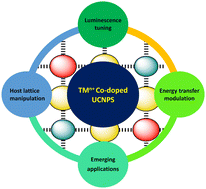Unravelling the benefits of transition-metal-co-doping in lanthanide upconversion nanoparticles
Abstract
Recent advances reveal that upconversion (UC) luminescent materials are highly important not just from a scientific, but also from a future application standpoint. Although significant progress has been made in this field in recent decades, still their versatile applications are hindered by the low upconversion luminescence intensity and low tuneability, which has hampered further implementation in real life applications. We find it highly beneficial to compile a summary of recent relevant literature and propose ways to enhance upconversion efficiency in lanthanide nanomaterials. One very promising way to tackle this problem is through implementing transition metal ion co-dopants into the materials, which is the focus of this tutorial review. In this review, the recent studies related to the tailored design of UC materials with transition metal ion co-dopants have been summarized, and the desirable functionality of transition metal ions in the host matrixes has been discussed. Apart from improving the upconversion efficiency, the implementation of transition metal-co-dopants into lanthanide upconversion materials has recently sparked interest in applications such as in vivo imaging, drug delivery or nanothermometers.

- This article is part of the themed collection: 2022 Emerging Investigators


 Please wait while we load your content...
Please wait while we load your content...